warning MINI COOPER 2005 Owner's Manual
[x] Cancel search | Manufacturer: MINI, Model Year: 2005, Model line: COOPER, Model: MINI COOPER 2005Pages: 165, PDF Size: 4.64 MB
Page 96 of 165
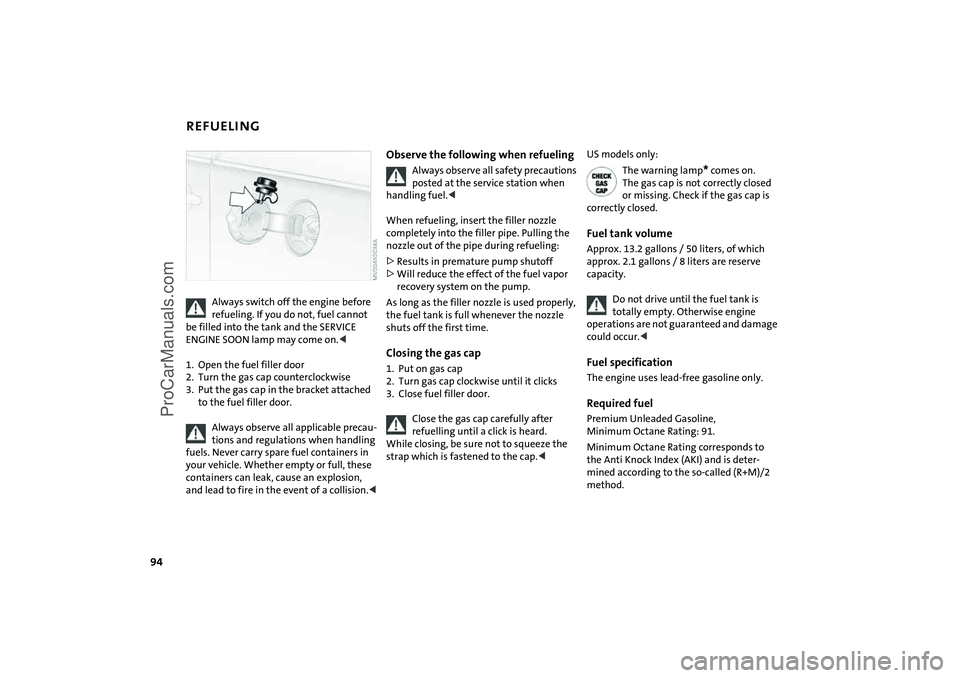
94
REFUELING
Always switch off the engine before refueling. If you do not, fuel cannot
be filled into the tank and the SERVICE
ENGINE SOON lamp may come on.<
1. Open the fuel filler door2. Turn the gas cap counterclockwise3. Put the gas cap in the bracket attached
to the fuel filler door.
Always observe all applicable precau
-
tions and regulations when handling
fuels. Never carry spare fuel containers in
your vehicle. Whether empty or full, these
containers can leak, cause an explosion,
and lead to fire in the event of a collision.<
Observe the following when refueling
Always observe all safety precautions posted at the service station when
handling fuel.<
When refueling, insert the filler nozzle
completely into the filler pipe. Pulling the
nozzle out of the pipe during refueling:>Results in premature pump shutoff>Will reduce the effect of the fuel vapor
recovery system on the pump.As long as the filler nozzle is used properly,
the fuel tank is full whenever the nozzle
shuts off the first time.Closing the gas cap1. Put on gas cap 2. Turn gas cap clockwise until it clicks3. Close fuel filler door.
Close the gas cap carefully after
refuelling until a click is heard.
While closing, be sure not to squeeze the
strap which is fastened to the cap.<
US models only:
The warning lamp
* comes on.
The gas cap is not correctly closed
or missing. Check if the gas cap is
correctly closed.
Fuel tank volumeApprox. 13.2
gallons
/ 50
liters, of which
approx. 2.1
gallons
/ 8
liters are reserve
capacity.
Do not drive until the fuel tank is totally empty. Otherwise engine
operations are not guaranteed and damage
could occur.<
Fuel specification The engine uses lead-free gasoline only.Required fuel Premium Unleaded Gasoline,
Minimum Octane Rating: 91.Minimum Octane Rating corresponds to
the Anti Knock Index (AKI) and is deter
-
mined according to the so-called (R+M)/2
method.
ProCarManuals.com
Page 98 of 165
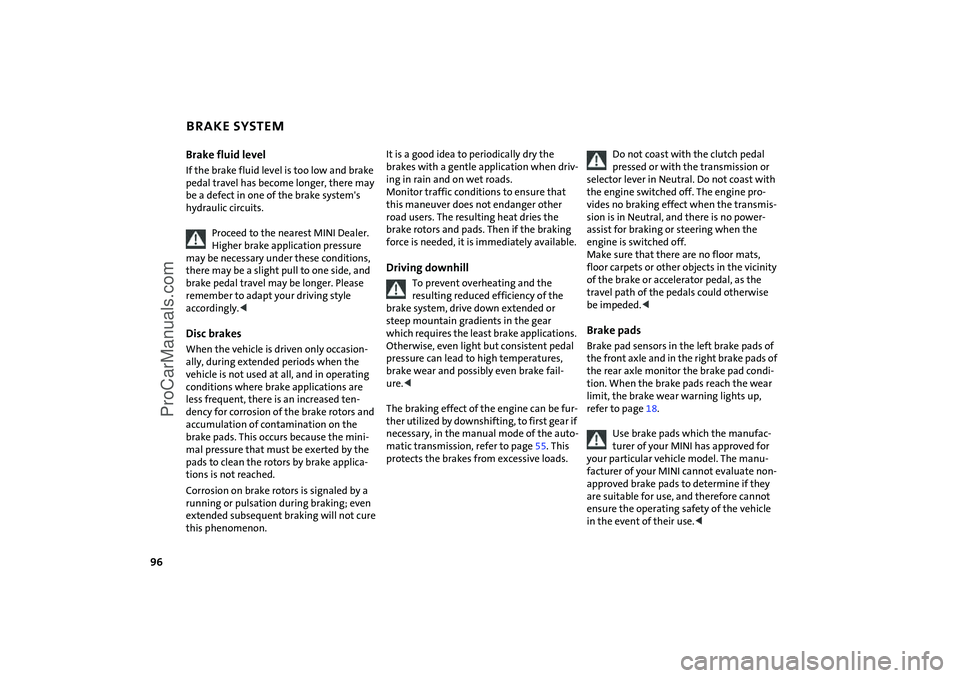
96
BRAKE SYSTEMBrake fluid levelIf the brake fluid level is too low and brake
pedal travel has become longer, there may
be a defect in one of the brake system's
hydraulic circuits.
Proceed to the nearest MINI Dealer. Higher brake application pressure
may be necessary under these conditions,
there may be a slight pull to one side, and
brake pedal travel may be longer. Please
remember to adapt your driving style
accordingly.<
Disc brakesWhen the vehicle is driven only occasion
-
ally, during extended periods when the
vehicle is not used at all, and in operating
conditions where brake applications are
less frequent, there is an increased ten
-
dency for corrosion of the brake rotors and
accumulation of contamination on the
brake pads. This occurs because the mini
-
mal pressure that must be exerted by the
pads to clean the rotors by brake applica
-
tions is not reached. Corrosion on brake rotors is signaled by a
running or pulsation during braking; even
extended subsequent braking will not cure
this phenomenon.
It is a good idea to periodically dry the
brakes with a gentle application when driv
-
ing in rain and on wet roads.
Monitor traffic conditions to ensure that
this maneuver does not endanger other
road users. The resulting heat dries the
brake rotors and pads. Then if the braking
force is needed, it is immediately available.Driving downhill
To prevent overheating and the resulting reduced efficiency of the
brake system, drive down extended or
steep mountain gradients in the gear
which requires the least brake applications.
Otherwise, even light but consistent pedal
pressure can lead to high temperatures,
brake wear and possibly even brake fail
-
ure.
ther utilized by downshifting, to first gear if
necessary, in the manual mode of the auto
-
matic transmission, refer to page
55. This
protects the brakes from excessive loads.
Do not coast with the clutch pedal pressed or with the transmission or
selector lever in Neutral. Do not coast with
the engine switched off. The engine pro
-
vides no braking effect when the transmis
-
sion is in Neutral, and there is no power-
assist for braking or steering when the
engine is switched off.
Make sure that there are no floor mats,
floor carpets or other objects in the vicinity
of the brake or accelerator pedal, as the
travel path of the pedals could otherwise
be impeded.
the rear axle monitor the brake pad condi
-
tion. When the brake pads reach the wear
limit, the brake wear warning lights up,
refer to page
18.
Use brake pads which the manufac
-
turer of your MINI has approved for
your particular vehicle model. The manu
-
facturer of your MINI cannot evaluate non-
approved brake pads to determine if they
are suitable for use, and therefore cannot
ensure the operating safety of the vehicle
in the event of their use.<
ProCarManuals.com
Page 111 of 165
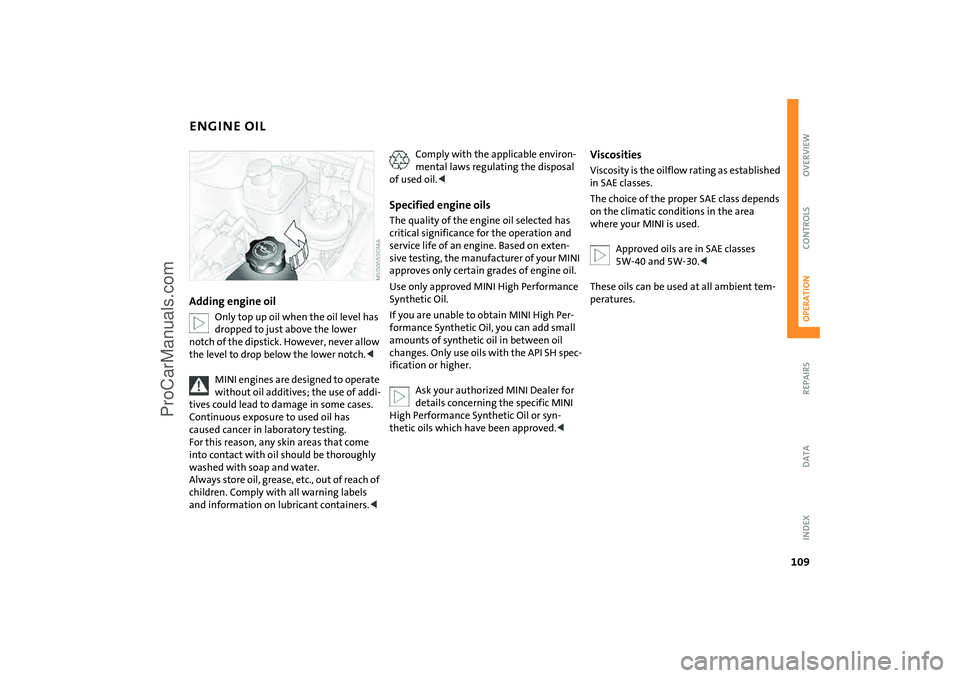
109
OVERVIEW REPAIRSOPERATIONCONTROLS DATA INDEX
ENGINE OILAdding engine oil
Only top up oil when the oil level has dropped to just above the lower
notch of the dipstick. However, never allow
the level to drop below the lower notch.
tives could lead to damage in some cases.
Continuous exposure to used oil has
caused cancer in laboratory testing.
For this reason, any skin areas that come
into contact with oil should be thoroughly
washed with soap and water.
Always store oil, grease, etc., out of reach of
children. Comply with all warning labels
and information on lubricant containers.<
Comply with the applicable environ
-
mental laws regulating the disposal
of used oil.<
Specified engine oilsThe quality of the engine oil selected has
critical significance for the operation and
service life of an engine. Based on exten
-
sive testing, the manufacturer of your MINI
approves only certain grades of engine oil. Use only approved MINI High Performance
Synthetic Oil.If you are unable to obtain MINI High Per
-
formance Synthetic Oil, you can add small
amounts of synthetic oil in between oil
changes. Only use oils with the API SH spec
-
ification or higher.
Ask your authorized MINI Dealer for details concerning the specific MINI
High Performance Synthetic Oil or syn
-
thetic oils which have been approved.<
Viscosities Viscosity is the oilflow rating as established
in SAE classes.The choice of the proper SAE class depends
on the climatic conditions in the area
where your MINI is used.
Approved oils are in SAE classes 5W-40 and 5W-30.<
These oils can be used at all ambient tem
-
peratures.
ProCarManuals.com
Page 113 of 165

111
OVERVIEW REPAIRSOPERATIONCONTROLS DATA INDEX
BRAKE FLUIDWarning lamp
The warning lamp comes on although the parking brake is
released:
The brake fluid level in the reservoir is too
low, refer to page
16. At the same time,
brake pedal travel may become signifi
-
cantly longer.
Have the system checked immediately.
Display of the malfunction described above in Canadian mod
-
els.
Adding brake fluid To add brake fluid or to determine and cor
-
rect the cause of brake fluid loss, please
consult your MINI Dealer. Your MINI Dealer
is familiar with the specifications for fac
-
tory-approved brake fluids,
DOT
4.
Brake fluid loss may result in extended
brake pedal travel. If this occurs, refer to
the information on page
96.
Brake fluid is hygroscopic, that is, it absorbs moisture from the air over
time.
In order to ensure the brake system's safety
and reliability, have the brake fluid
changed every two years by a MINI Dealer
or a workshop that has specially trained
personnel working in accordance with the
specifications of the MINI manufacturer,
also refer to the Service and Warranty
Information Booklet for US
models or the
Warranty and Service Guide Booklet for
Canadian models. Brake fluid is toxic and
also damages vehicle paintwork. Always
store brake fluid in tightly closed original
containers kept well away from the reach
of children.
Do not spill the brake fluid and do not fill
the brake fluid reservoir beyond the MAX
mark. The brake fluid could ignite upon
contact with hot engine parts and cause
serious burns.<
Comply with the applicable environ
-
mental laws regulating the disposal
of brake fluid.<
ProCarManuals.com
Page 127 of 165

125
OVERVIEW REPAIRSOPERATION CONTROLS DATA INDEX
REPAIRING A FLAT TIRE
SPACE-SAVER SPARE TIRE
*
Safety measures in the event of a flat tire:
Stop the vehicle as far as possible from
passing traffic. Switch on the hazard warn
-
ing flashers.
Turn the steering wheel to the straight-
ahead wheel position and engage the
steering lock. Engage the parking brake and
shift into 1st or reverse gear – selector lever
in P.
All passengers should be outside the vehi
-
cle and well away from your immediate
working area – behind a guardrail, for
instance.
If a portable hazard warning lamp is avail
-
able, set it up on the roadside at an appro
-
priate distance from the rear of the vehicle.
Comply with all safety guidelines and regu
-
lations.
dures should be followed depending on the
equipment included in your vehicle:>Vehicles with Run Flat tires, refer to
page
101
>Vehicles with a space-saver spare tire,
refer to the following section>Vehicles with MINI Mobility System,
refer to page
129
.
To change a space-saver spare tire, proceed
as follows:>Remove space-saver spare tire, refer to
the section after the next one>Prepare for tire change, refer to page
127
>Jack up the vehicle, refer to page
128
>Mount the space-saver spare tire, refer
to page
128
>Tighten the lug bolts, refer to page
128
>Drive with space-saver spare tire, refer to
page
127
.
Tire change setOn vehicles with a space-saver spare tire,
the tire change set with onboard tools is
stored in the luggage compartment under
the floor mat.1 Chock, folding2 Hubcap remover3 Wheel stud wrench4Jack5 Special wrench for removing the space-
saver spare tire6 Towing eyelet7 Lifting handleThe onboard tool kit includes a pouch with
a plastic bag in which you can place the
damaged wheel.
ProCarManuals.com
Page 131 of 165
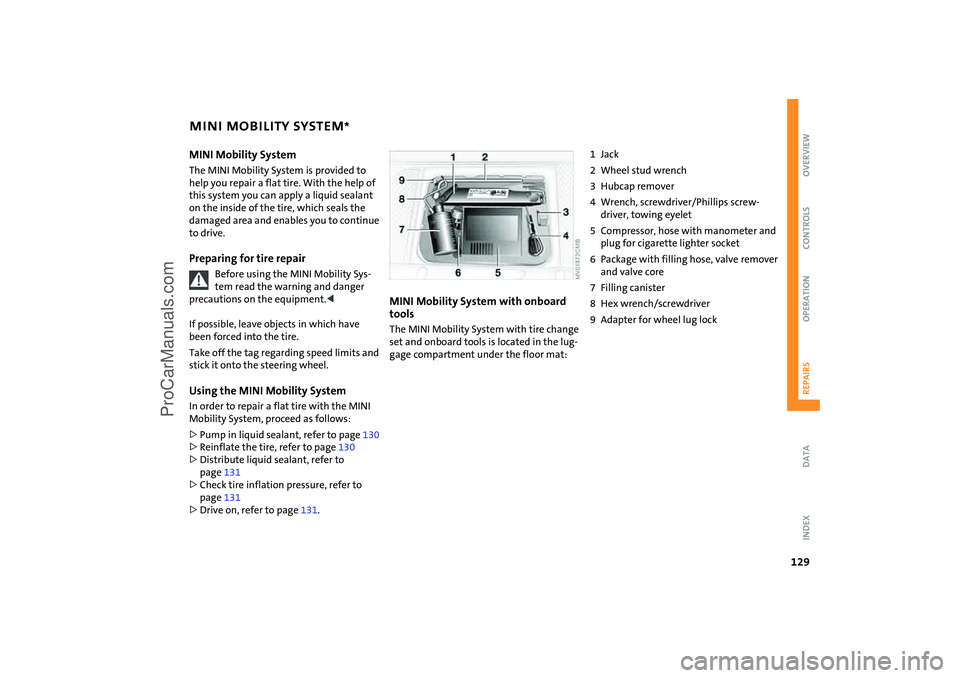
129
OVERVIEW REPAIRSOPERATION CONTROLS DATA INDEX
MINI MOBILITY SYSTEM
*
MINI Mobility SystemThe MINI Mobility System is provided to
help you repair a flat tire. With the help of
this system you can apply a liquid sealant
on the inside of the tire, which seals the
damaged area and enables you to continue
to drive. Preparing for tire repair
Before using the MINI Mobility Sys
-
tem read the warning and danger
precautions on the equipment.<
If possible, leave objects in which have
been forced into the tire.Take off the tag regarding speed limits and
stick it onto the steering wheel.Using the MINI Mobility SystemIn order to repair a flat tire with the MINI
Mobility System, proceed as follows:>Pump in liquid sealant, refer to page
130
>Reinflate the tire, refer to page
130
>Distribute liquid sealant, refer to
page
131
>Check tire inflation pressure, refer to
page
131
>Drive on, refer to page
131
.
MINI Mobility System with onboard tools The MINI Mobility System with tire change
set and onboard tools is located in the lug
-
gage compartment under the floor mat:
1Jack2 Wheel stud wrench3 Hubcap remover4 Wrench, screwdriver/Phillips screw
-
driver, towing eyelet5 Compressor, hose with manometer and
plug for cigarette lighter socket6 Package with filling hose, valve remover
and valve core7 Filling canister8 Hex wrench/screwdriver9 Adapter for wheel lug lock
ProCarManuals.com
Page 138 of 165

136
TOWING AND TOW-STARTINGUsing the towing eyelet The screw-in towing eyelet is stored in the
onboard tool kit, refer to page
120
; be sure
that it remains with the vehicle at all times.
It can be attached at the front or rear of
your vehicle.
To prevent damage to the towing eyelet and the vehicle, please observe
the following instructions:
Use only the towing eyelet supplied with
the vehicle and screw it in firmly until it
stops. Use the towing eyelet for towing on
paved roads only. Avoid subjecting the
towing eyelet to lateral loads, e.g. do not
lift the vehicle using the towing eyelet.<
Access to the threaded socket The illustration shows by way of example
the MINI COOPER and the MINI COOPER
Convertible.Pry out the cover in the front or rear
bumper by inserting a screwdriver into the
recess.Being towed
Make sure that the ignition key is in position
1; otherwise the steering
lock could engage and prevent the vehicle
from being steered. There is no power
assist while the engine is off. Therefore,
you will need to exert more force to brake
and steer the vehicle.<
Turn on the hazard warning flashers, if
required by national regulations. If the
electrical system has failed, clearly identify
the vehicle being towed, e.g. by placing a
sign or a warning triangle in the rear win
-
dow.MINI or MINI Convertible with manual
transmission:Put the manual gearshift lever in Neutral.MINI or MINI Convertible with Continu
-
ously Variable automatic Transmission
(CVT):
Only tow vehicles with Continuously Variable automatic Transmission
(CVT) with a tow truck, otherwise the trans
-
mission can be damaged, refer to
page
137
.<
Towing methodsIn some countries, it is not permitted to
tow the vehicle with a tow bar or tow rope
on public roads.Familiarize yourself with the applicable
towing regulations for the country in which
you are driving.
ProCarManuals.com
Page 139 of 165

137
OVERVIEW REPAIRSOPERATION CONTROLS DATA INDEX
TOWING AND TOW-STARTINGWith a tow bar:
The towing vehicle must not be lighter than the vehicle being towed;
otherwise, vehicle handling can no longer
be controlled.<
The towing eyelets of both vehicles should
be on the same side. If the tow bar can only
be used in a diagonal position, please note
the following:>Clearance and maneuverability will be
strictly limited in corners>The inclination of the tow bar produces
lateral force.
Only attach the tow bar to the towing eyelets. Other parts of the vehicles
could otherwise be damaged.<
With a tow rope: When the towing vehicle is driving off,
make sure that the tow rope is taut.
Use nylon ropes or straps for towing because they prevent sudden jerking
movements. Attach the tow rope only to
the towing eyelets. Other parts of the vehi
-
cles could otherwise be damaged.<
With a tow truck:Have the MINI or MINI Convertible trans
-
ported by a tow truck with a lift sling, or on
a flatbed.
Only tow vehicles with Continuously Variable automatic Transmission
(CVT) with the front wheels raised or on a
special transport vehicle, otherwise the
transmission can be damaged.
Do not lift the vehicle by the towing eyelet,
nor by parts of the body or chassis. Other
-
wise damage could result.<
Tow-starting
Do not tow-start vehicles with Con
-
tinuously Variable automatic Trans
-
mission (CVT).
Jump-starting, refer to page
134
.<
Only tow-start vehicles with catalytic con
-
verters if the engine is cold. It is better to
have the engine jump-started, refer to
page
134
.
1. Turn on the hazard warning flashers;
comply with national regulations2. Turn the ignition key to position
2
3. Engage the 3rd
gear
4. Have the vehicle towed with the clutch
pedal completely depressed and then
slowly release the clutch pedal. After the
engine has started, immediately depress
the clutch pedal again completely5. Pull over at a suitable location, remove
the tow bar or tow rope, and turn off the
hazard warning flashers6. Have the vehicle checked.
ProCarManuals.com
Page 150 of 165
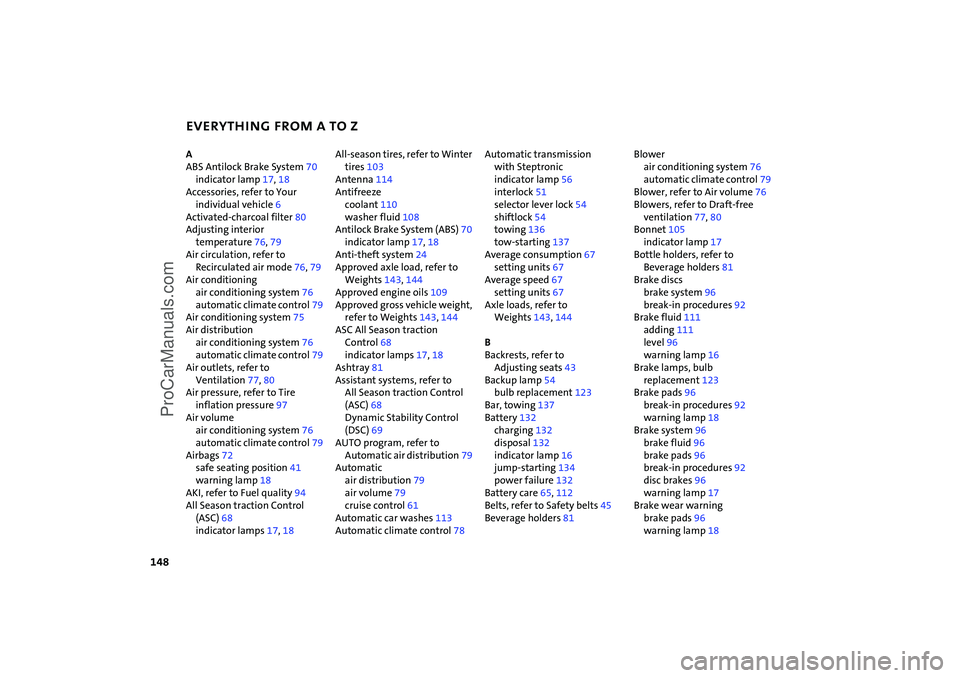
EVERYTHING FROM A TO Z
148
A ABS Antilock Brake System
70
indicator lamp
17, 18
Accessories, refer to Your
individual vehicle
6
Activated-charcoal filter
80
Adjusting interior
temperature
76, 79
Air circulation, refer to
Recirculated air mode
76, 79
Air conditioning
air conditioning system
76
automatic climate control
79
Air conditioning system
75
Air distribution
air conditioning system
76
automatic climate control
79
Air outlets, refer to
Ventilation
77, 80
Air pressure, refer to Tire
inflation pressure
97
Air volume
air conditioning system
76
automatic climate control
79
Airbags
72
safe seating position
41
warning lamp
18
AKI, refer to Fuel quality
94
All Season traction Control
(ASC)
68
indicator lamps
17, 18
All-season tires, refer to Winter
tires
103
Antenna
114
Antifreeze
coolant
110
washer fluid
108
Antilock Brake System (ABS)
70
indicator lamp
17, 18
Anti-theft system
24
Approved axle load, refer to
Weights
143
, 144
Approved engine oils
109
Approved gross vehicle weight,
refer to Weights
143
, 144
ASC All Season traction
Control
68
indicator lamps
17, 18
Ashtray
81
Assistant systems, refer to
All Season traction Control
(ASC)
68
Dynamic Stability Control
(DSC)
69
AUTO program, refer to
Automatic air distribution
79
Automatic
air distribution
79
air volume
79
cruise control
61
Automatic car washes
113
Automatic climate control
78
Automatic transmission
with Steptronic
indicator lamp
56
interlock
51
selector lever lock
54
shiftlock
54
towing
136
tow-starting
137
Average consumption
67
setting units
67
Average speed
67
setting units
67
Axle loads, refer to
Weights
143
, 144
B Backrests, refer to
Adjusting seats
43
Backup lamp
54
bulb replacement
123
Bar, towing
137
Battery
132
charging
132
disposal
132
indicator lamp
16
jump-starting
134
power failure
132
Battery care
65, 112
Belts, refer to Safety belts
45
Beverage holders
81
Blower
air conditioning system
76
automatic climate control
79
Blower, refer to Air volume
76
Blowers, refer to Draft-free
ventilation
77, 80
Bonnet
105
indicator lamp
17
Bottle holders, refer to
Beverage holders
81
Brake discs
brake system
96
break-in procedures
92
Brake fluid
111
adding
111
level
96
warning lamp
16
Brake lamps, bulb
replacement
123
Brake pads
96
break-in procedures
92
warning lamp
18
Brake system
96
brake fluid
96
brake pads
96
break-in procedures
92
disc brakes
96
warning lamp
17
Brake wear warning
brake pads
96
warning lamp
18
ProCarManuals.com
Page 151 of 165

EVERYTHING FROM A TO Z
149
OVERVIEW REPAIRS OPERATION CONTROLS DATA INDEX
Brakes
96
ABS
70
brake fluid
111
brake pads
96
break-in procedures
92
handbrake
53
indicator/warning
lamps
16, 17, 18
Breaking in
92
Bulb replacement, refer to
Lamps and bulbs
121
Buttons in multifunction
steering wheel
20
Continuously Variable
automatic Transmission
(CVT)
56
C California Proposition 65
warning
7
Capacities
145
Car care, refer to Caring for your
vehicle
113
Car keys, refer to Keys
24
Car radio, refer to separate Owner's Manual
Car telephone, refer to separate Owner's Manual
Car vacuum cleaner,
connecting, refer to Cigarette
lighter socket
82
Car wash
113
Car wash, refer to Washing
your vehicle
113
Car-care products
113
Care of plastics
114
Care of synthetic leather
114
Care, vehicle
113
Cargo area cover, refer to
Luggage compartment
cover
85
Cargo area, refer to Luggage
compartment in the MINI
85
Cargo area, refer to Luggage
compartment in the MINI
Convertible
86
Carpet care
115
Cassette operation, refer to
Owner's Manual for Radio
Catalytic converter, refer to
Hot exhaust system
93
CBC Cornering Brake Control
70
CD changer, refer to Owner's Manual for Radio
CD operation, refer to
Owner's Manual for Radio
Central locking system
24
interior
28
Changing bulbs
121
Changing the wiper
blades
120
, 121
Changing tires
127
space-saver spare tire
125
Charge-current indicator
light
16
Child seat, refer to Installing
child-restraint systems
49
Children, transporting
48
Child-restraint mounting
system, LATCH
50
Child-restraint systems
48
Chock, folding
space-saver spare tire
125
Chrome parts, refer to Caring
for your vehicle
114
Chrome-plated parts, care
114
Cigarette lighter
82
Cigarette lighter socket
82
Circulation of air, refer to
Recirculated air mode
76, 79
Cleaning the rear window
60
Cleaning the vehicle, refer to
Caring for your vehicle
113
Clock
63
12-hour/24-hour mode
63
changing the time
63
Closing
from inside
28
from outside
25
Clothes hooks
93
Clutch
51
break-in procedures
92
Cockpit
12
Coding, tires
99
Cold start, refer to
Starting the engine
52
Compact disk operation, refer to Owner's Manual for Radio
Compartments
81
Computer, refer to Onboard
computer
66
Condensed water, refer to Air
conditioning
76, 79
Configuring settings, refer to
Vehicle Memory
47
Consumption, refer to
Average consumption
67
Current fuel consumption
67
Contents
2
Continuously Variable
automatic Transmission
(CVT)
54
ignition
51
indicator lamp
56
interlock
51
selector lever lock
54
shiftlock
54
towing
136
tow-starting
137
Control elements, refer to
Cockpit
12
ProCarManuals.com